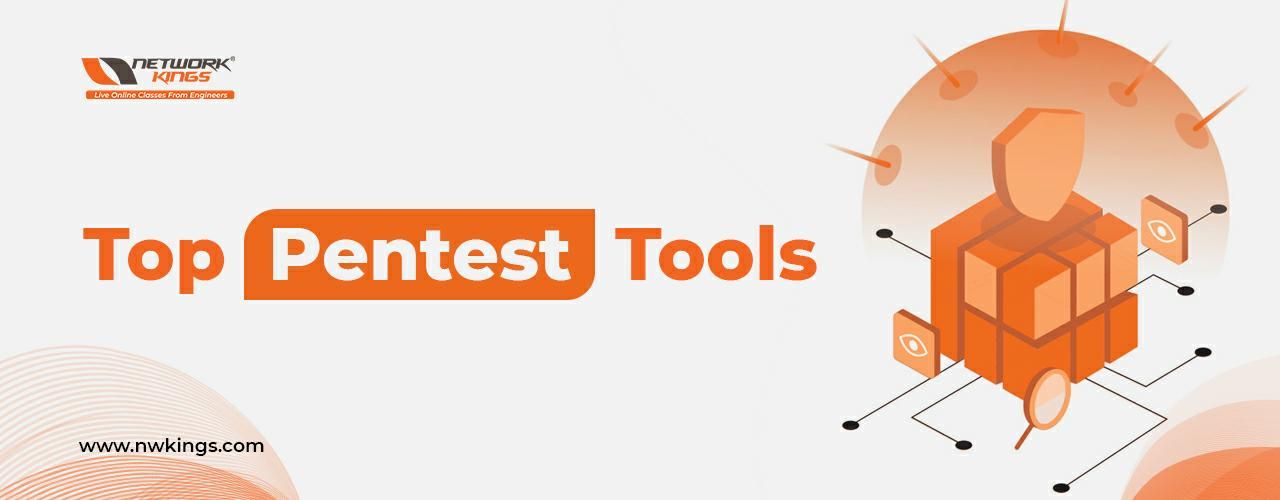
Penetration testing or PenTest is a security exercise where a cyber-security expert emulates a cyberattack to discover and exploit openness in a computer system. The goal is to determine weak spots in a system’s protection that attackers could use to achieve access.
Penetration testers use the same tools, techniques, and procedures as attackers to discover and explain the business impacts of weaknesses in a system. Penetration testers are security professionals trained in ethical hacking, which is the use of hacking tools and techniques to improve security weaknesses rather than cause damage.
Penetration tests also prepare you for potential problems, so you can address them quickly and with confidence should they occur in a real scenario. Assess potential impacts: Pen testing allows you to predict future challenges and judges how well your platform’s security defenses perform against specific attacks.
This blog will allow you to know all about penetration testing tools.
What is Penetration Testing?
Penetration testing tools are used as part of a penetration test(Pen Test) to automate certain tasks, improve testing efficiency, and discover issues that might be difficult to find using manual analysis techniques alone.
What are the different types of Penetration Testing?
There are different types of Penetration Testing:
- External Network Penetration Testing: This type of testing simulates an attack from outside the network to identify vulnerabilities that could be exploited by external threat actors.
- Internal Network Penetration Testing: It focuses on assessing the security of internal network systems and resources, usually from the perspective of a malicious insider.
- Web Application Penetration Testing: This involves evaluating the security of web applications by identifying and exploiting vulnerabilities that could compromise the application and its data.
- Wireless Penetration Testing: It assesses the security of wireless networks, including Wi-Fi, to uncover potential vulnerabilities that could be exploited by unauthorized users.
- Physical Penetration Testing: This type of testing evaluates physical security controls, such as access controls and surveillance systems, to identify weaknesses that could be exploited by attackers.
- Social Engineering Penetration Testing: It assesses the effectiveness of security awareness training and policies by simulating social engineering attacks to manipulate employees into divulging sensitive information or performing unauthorized actions.
- Client-Side Penetration Testing: It focuses on assessing the security of client-side applications and components, such as browsers, plugins, and other software installed on user devices.
- IoT Penetration Testing: This type of testing evaluates the security of Internet of Things devices and systems to identify vulnerabilities that could be exploited to compromise the devices or the network they are connected to.
- Mobile App Penetration Testing: This involves assessing the security of mobile applications on various platforms to identify vulnerabilities that could be exploited by attackers to compromise the application or the device.
- Red Team Penetration Testing: This type of testing simulates a real-world attack scenario where a team of skilled professionals (Red Team) attempts to breach an organization’s security defenses to identify weaknesses and improve overall security posture.
What are the benefits of penetration testing?
Penetration testing, also known as pen testing, is a proactive approach to identifying vulnerabilities in a system, network, or application by simulating real-world cyber attacks. Here are some benefits of penetration testing:
- Identifying Weaknesses: Penetration testing helps in identifying vulnerabilities and weaknesses in the system that malicious actors could exploit. By uncovering these weaknesses, organizations can take steps to strengthen their security measures.
- Risk Management: By conducting penetration tests regularly, organizations can assess the level of risk they face from potential cyber-attacks. This information can help in prioritizing security measures and allocating resources effectively.
- Compliance Requirements: Many industries have regulatory requirements for cybersecurity, and penetration testing is often a part of these compliance measures. By conducting regular tests, organizations can ensure they meet these requirements.
- Enhancing Security Measures: Penetration testing provides valuable insights into the effectiveness of existing security measures. Organizations can use the findings to improve their security posture and better protect their assets.
- Preventing Data Breaches: Identifying vulnerabilities through penetration testing helps in preventing data breaches. By proactively addressing security gaps, organizations can reduce the risk of sensitive data being compromised.
- Building Trust: Customers and stakeholders trust organizations that take cybersecurity seriously. Conducting penetration tests and demonstrating a commitment to security can enhance trust and reputation in the marketplace.
- Cost Savings: Detecting and addressing security vulnerabilities early through penetration testing can save organizations significant costs that may arise from data breaches, legal issues, and damage to reputation.
Categories of Pentest Tools
There are different categories of PenTest tools:
Information Gathering Tools: Information gathering is all about collecting information about the target system or network. It is the first and one of the most important steps in penetration testing.
Vulnerability Assessment Tools: Vulnerability assessment tools discover which exposures are present, but they do not differentiate between flaws that can be exploited to force damage and those that cannot. Vulnerability scanners warn companies of the preexisting flaws in their code and where they are located.
Exploitation Tools: Exploitation tools are automated tools that can control exposures found by scanning tools or by your analysis. They can help you gain entry, escalate requests, run commands, install backdoors, or exfiltrate data from the target system or network.
Post-Exploitation Tools: Post-exploitation guides to any actions taken after a session is opened. A session is an open shell from a thriving exploit or bruteforce attack. A shell can be a standard shell or a Meterpreter. To know more about the difference between each, see Manage Meterpreter and Shell Sessions.
Reporting Tools: Using data reporting software, you can collect business data and present it in charts and other visual formats. If your job entails data reporting, it is beneficial to be familiar with the tools that can facilitate the process effectively.
PenTest Tools for Windows: Penetration testing (pentest) tools automate tasks, improve testing efficiency, and find issues that are hard to locate with manual research. A pentest affects a cyberattack to set a network’s security.
What are the most popular Pentest Tools?
Let’s explore the top 8 pentest tools used by cybersecurity experts to secure their networks and applications.
- Nmap: Nmap is a network scanning tool—an open-source Linux command-line tool—used for network exploration, host discovery, and security auditing.
- Metasploit: Metasploit is the world’s ruling open-source penetrating framework used by security engineers as a penetration testing system and a development platform that allows to creation of security tools and exploits. The framework makes hacking simple for both attackers and defenders.
- Burp Suite: Burp Suite is an integrated platform and graphical tool for conducting security testing of web applications, it helps complete the testing process, from initial mapping and examination of an application’s attack surface to discovering and using security exposures.
- Wireshark: Wireshark has many benefits, including troubleshooting networks that have performance issues. Cybersecurity professionals often use Wireshark to draft connections, view the contents of suspect network transactions, and determine bursts of network traffic.
- Aircrack-ng: Aircrack-ng is a set of tools used for testing the security of wireless networks. It includes tools for capturing packets, cracking WEP and WPA/WPA2-PSK encryption keys, and conducting wireless network audits. Aircrack-ng is widely used by pentesters to assess the security of Wi-Fi networks and identify potential vulnerabilities that could be exploited by malicious actors.
- SQLMap: SQLMap is a powerful open-source tool for detecting and exploiting SQL injection vulnerabilities in web applications. It automates the process of identifying SQL injection flaws, extracting database information, and gaining unauthorized access to backend systems. SQLMap supports various database management systems, including MySQL, PostgreSQL, and Microsoft SQL Server, making it a valuable tool for pentesters conducting web application assessments.
- Hydra: Hydra is a fast and flexible password-cracking tool that supports multiple protocols, including HTTP, FTP, SSH, and SMB. It enables pentesters to perform brute-force attacks against login credentials and test the strength of passwords used in target systems. Hydra’s multi-threaded approach and support for parallel attacks make it an efficient tool for cracking passwords and gaining unauthorized access to protected resources.
- John the Ripper: John the Ripper is a widely-used password-cracking tool that can crack password hashes using various attack modes, including dictionary attacks, brute-force attacks, and rainbow table attacks. It supports multiple hash types and can crack passwords from various operating systems and applications. John the Ripper is a versatile tool for pentesters looking to test the strength of password policies and secure sensitive information stored in password-protected files.
Where to pursue the PenTest training?
At Network Kings, you can enjoy the following training benefits-
- Get 24×7 access to the world’s biggest virtual labs with zero downtime.
- Learn from the world’s best top-notch cybersecurity engineers with over 12+ years of experience.
- Frequent doubt-clearance sessions with the experts.
- Get prepared to take the latest PT0-002 exam
What are the available job opportunities after CompTIA PenTest+ training?
You can explore various jobs after earning the CompTIA PenTest+ training certification, such as
- Penetration Tester
- Ethical Hacker
- Security Consultant
- Security Analyst
- Vulnerability Assessor
- Cybersecurity Engineer
- Incident Response Analyst
- Information Security Manager
- Network Security Engineer
- Security Operations Center (SOC) Analyst
- Cybersecurity Specialist
- Security Architect
- Red Team Operator
- Blue Team Operator
- Cybersecurity Trainer/Instructor
- Forensic Analyst
- Risk Analyst
- Security Auditor
- Compliance Officer
- Cybersecurity Program Manager
What are the salary prospects after the CompTIA PenTest+ Course?
The estimated salary prospects for a candidate after completing the CompTIA PenTest+ training in different countries are as follows-
- United States: USD 72,000 – USD 152,000 per year
- Canada: CAD 67,000 – CAD 120,000 per year
- United Kingdom: GBP 37,000 – GBP 76,000 per year
- Australia: AUD 76,000 – AUD 142,000 per year
- Germany: EUR 49,000 – EUR 100,000 EUR per year
- France: EUR 40,000 – EUR 80,000 per year
- Spain: EUR 30,000 – EUR 70,000 per year
- Italy: EUR 30,000 – EUR 60,000 per year
- India: INR 350,000 – INR 1,200,000 per year
- Brazil: BRL 60,000 – BRL 120,000 per year
- Mexico: MXN 400,000 – MXN 900,000 per year
- South Africa: ZAR 240,000 – ZAR 480,000 per year
- Saudi Arabia: SAR 120,000 – SAR 250,000 per year
- United Arab Emirates: AED 120,000 – AED 300,000 per year
- Singapore: SGD 70,000 – SGD 150,000 per year
Conclusion
Penetration Testing is a process to see security bugs within a software program or a computer network. It is utilized to see flaws or defects within a current software or computer network to make it safer.
A penetration test picks out the backdoors, misconfigurations, and other vulnerabilities in your network. By using this information to train your developers, you can avoid these mistakes in the future and increase your security.


